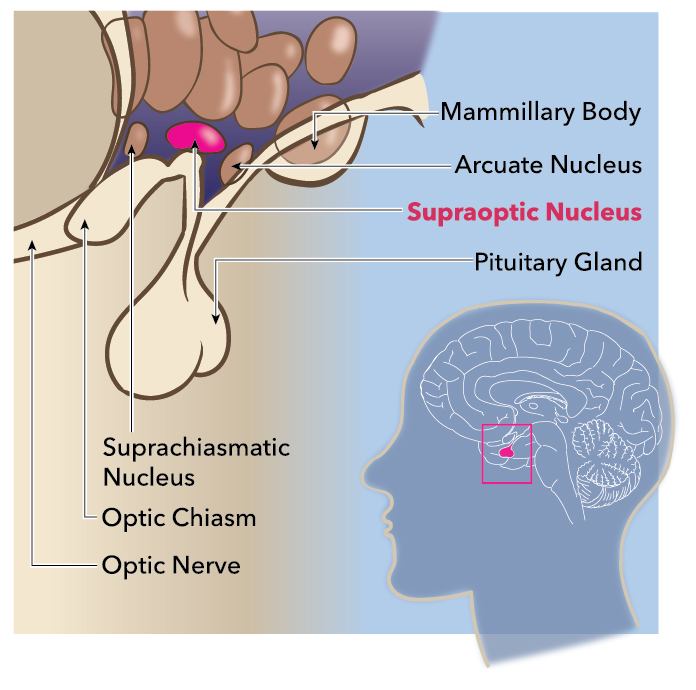[1]
Aguilera G. HPA axis responsiveness to stress: implications for healthy aging. Experimental gerontology. 2011 Feb-Mar:46(2-3):90-5. doi: 10.1016/j.exger.2010.08.023. Epub 2010 Sep 9
[PubMed PMID: 20833240]
[2]
Brown CH. Magnocellular Neurons and Posterior Pituitary Function. Comprehensive Physiology. 2016 Sep 15:6(4):1701-1741. doi: 10.1002/cphy.c150053. Epub 2016 Sep 15
[PubMed PMID: 27783857]
[3]
Wilkin LD, Mitchell LD, Ganten D, Johnson AK. The supraoptic nucleus: afferents from areas involved in control of body fluid homeostasis. Neuroscience. 1989:28(3):573-84
[PubMed PMID: 2710332]
[5]
Lee HJ, Macbeth AH, Pagani JH, Young WS 3rd. Oxytocin: the great facilitator of life. Progress in neurobiology. 2009 Jun:88(2):127-51. doi: 10.1016/j.pneurobio.2009.04.001. Epub 2009 Apr 10
[PubMed PMID: 19482229]
[6]
Flament-Durand J. The hypothalamus: anatomy and functions. Acta psychiatrica Belgica. 1980 Jul-Aug:80(4):364-75
[PubMed PMID: 7025580]
[7]
Krsulovic J, Peruzzo B, Alvial G, Yulis CR, Rodríguez EM. The destination of the aged, nonreleasable neurohypophyseal peptides stored in the neural lobe is associated to the remodeling of the neurosecretory axon. Microscopy research and technique. 2005 Dec 15:68(6):347-59
[PubMed PMID: 16358285]
[8]
Silva MP, Cedraz-Mercez PL, Varanda WA. Effects of nitric oxide on magnocellular neurons of the supraoptic nucleus involve multiple mechanisms. Brazilian journal of medical and biological research = Revista brasileira de pesquisas medicas e biologicas. 2014 Feb:47(2):90-100. doi: 10.1590/1414-431X20133326. Epub 2014 Jan 17
[PubMed PMID: 24519124]
[10]
Brown CH, Bains JS, Ludwig M, Stern JE. Physiological regulation of magnocellular neurosecretory cell activity: integration of intrinsic, local and afferent mechanisms. Journal of neuroendocrinology. 2013 Aug:25(8):678-710. doi: 10.1111/jne.12051. Epub
[PubMed PMID: 23701531]
[11]
Crespo D, Ramos J, Gonzalez C, Fernandez-Viadero C. The supraoptic nucleus: a morphological and quantitative study in control and hypophysectomised rats. Journal of anatomy. 1990 Apr:169():115-23
[PubMed PMID: 2384330]
[12]
Swaab DF, Hofman MA, Lucassen PJ, Purba JS, Raadsheer FC, Van de Nes JA. Functional neuroanatomy and neuropathology of the human hypothalamus. Anatomy and embryology. 1993 Apr:187(4):317-30
[PubMed PMID: 8512084]
[13]
Yukitake Y, Taniguchi Y, Kurosumi K. Ultrastructural studies on the secretory cycle of the neurosecretory cells and the formation of Herring bodies in the paraventricular nucleus of the rat. Cell and tissue research. 1977 Feb 2:177(1):1-8
[PubMed PMID: 65228]
[14]
Daniel PM. The blood supply of the hypothalamus and pituitary gland. British medical bulletin. 1966 Sep:22(3):202-8
[PubMed PMID: 5329958]
[15]
Wang Y, Zhao C, Wang Z, Wang C, Feng W, Huang L, Zhang J, Qi S. Apoptosis of supraoptic AVP neurons is involved in the development of central diabetes insipidus after hypophysectomy in rats. BMC neuroscience. 2008 Jun 25:9():54. doi: 10.1186/1471-2202-9-54. Epub 2008 Jun 25
[PubMed PMID: 18578860]
Level 2 (mid-level) evidence
[16]
Dohanics J, Hoffman GE, Smith MS, Verbalis JG. Functional neurolobectomy induced by controlled compression of the pituitary stalk. Brain research. 1992 Mar 20:575(2):215-22
[PubMed PMID: 1571781]
[17]
Elias PC, Elias LL, Castro M, Antunes-Rodrigues J, Moreira AC. Hypothalamic-pituitary-adrenal axis up-regulation in rats submitted to pituitary stalk compression. The Journal of endocrinology. 2004 Feb:180(2):297-302
[PubMed PMID: 14765982]
[18]
Raisman G. An ultrastructural study of the effects of hypophysectomy on the supraoptic nucleus of the rat. The Journal of comparative neurology. 1973 Jan 15:147(2):181-207
[PubMed PMID: 4682774]
Level 2 (mid-level) evidence
[19]
BODIAN D, MAREN TH. The effect of neuro- and adenohypophysectomy on retrograde degeneration in hypothalamic nuclei of the rat. The Journal of comparative neurology. 1951 Jun:94(3):485-511
[PubMed PMID: 14850590]
Level 2 (mid-level) evidence
[20]
Herman JP, Marciano FF, Gash DM. Vasopressin administration prevents functional recovery of the vasopressinergic neurosecretory system following neurohypophysectomy. Neuroscience letters. 1986 Dec 23:72(3):239-46
[PubMed PMID: 3822229]
Level 3 (low-level) evidence
[21]
Miller JH, Grattan DR, Averill RL. Effect of alcohol, neurohypophysectomy, and vasopressin antagonists on hemorrhage-induced bradycardia in the rat. Proceedings of the Society for Experimental Biology and Medicine. Society for Experimental Biology and Medicine (New York, N.Y.). 1993 Mar:202(3):320-30
[PubMed PMID: 8437988]
[22]
CAMPAGNA MJ, DODGE HW Jr, CLARK EC. Water exchange in dogs following partial section of the pituitary stalk. The American journal of physiology. 1957 Oct:191(1):59-63
[PubMed PMID: 13478685]
[23]
HICKMAN JA. The effect of section of the pituitary stalk on the supraoptic and paraventricular nuclei of the ferret. The Journal of endocrinology. 1961 Jul:22():371-6
[PubMed PMID: 13714132]
[24]
Alonso G, Bribes E, Chauvet N. Survival and regeneration of neurons of the supraoptic nucleus following surgical transection of neurohypophysial axons depend on the existence of collateral projections of these neurons to the dorsolateral hypothalamus. Brain research. 1996 Mar 4:711(1-2):34-43
[PubMed PMID: 8680872]
[25]
Shepshelovich D, Leibovitch C, Klein A, Zoldan S, Milo G, Shochat T, Rozen-zvi B, Gafter-Gvili A, Lahav M. The syndrome of inappropriate antidiuretic hormone secretion: Distribution and characterization according to etiologies. European journal of internal medicine. 2015 Dec:26(10):819-24. doi: 10.1016/j.ejim.2015.10.020. Epub 2015 Nov 10
[PubMed PMID: 26563934]
[26]
Lu HA. Diabetes Insipidus. Advances in experimental medicine and biology. 2017:969():213-225. doi: 10.1007/978-94-024-1057-0_14. Epub
[PubMed PMID: 28258576]
Level 3 (low-level) evidence

